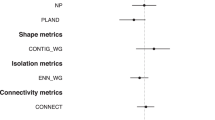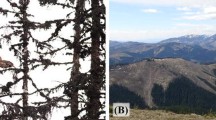Abstract
We identified wildlife corridors as linkages for carabid migration between two fragmented forests. Three wildlife corridors, constructed in 2007 to connect two forests fragmented by a two-lane road in South Korea, were selected. We collected 982 individuals of 13 carabid species from the wildlife corridors and connected forests. Carabid diversity in the forest sites was significantly higher than in the wildlife corridor sites. The number of individuals of carabid beetle species within wildlife corridor sites was significantly correlated with flight capacity of the species. Carabid beetles were concentrated closest to the forest edge, which resulted in a steady decline in carabid richness and number of individuals further away from the edge of the forest fragment to the center of the corridor, because environmental variables in the corridor were not comparable to those of the forest fragments. Canonical correspondence analysis revealed that trap sites were clearly divided into forest fragment and wildlife corridor sites. Carabid preference for forest habitat was strongly associated with tree cover, whereas their preference for corridors was correlated with exposed areas and grass cover, respectively. Thus, in forested regions, wildlife corridors with dry grassland or open areas provide a heterogeneous habitat for carabids.



Similar content being viewed by others
References
Abildsnes J, Tommeras B (2000) Impacts of experimental habitat fragmentation on ground beetles (Coleoptera, Carabidae) in a boreal spruce forest. Ann Zool Fenn 37:201–212
Andrews A (1990) Fragmentation of habitat by roads and utility corridors: a review. Aust Zool 26:130–141
Baars M (1979) Patterns of movement of radioactive carabid beetles. Oecologia 44:125–140
Barrows CW, Fleming KD, Allen MF (2011) Identifying habitat linkages to maintain connectivity for corridor dwellers in a fragmented landscape. J Wildl Manage 75:682–691
Beier P, Noss RF (1998) Do habitat corridors provide connectivity? Conserv Biol 12:1241–1252
Beier P, Majka DR, Spencer WD (2008) Forks in the road: choices in procedures for designing wildland linkages. Conserv Biol 22:836–851
Brooks DR et al (2012) Large carabid beetle declines in a United Kingdom monitoring network increases evidence for a widespread loss in insect biodiversity. J Appl Ecol 49:1009–1019
Delgado JD, Morales GM, Arroyo NL, Fernández-Palacios JM (2013) The responses of leaf litter invertebrates to environmental gradients along road edges in subtropical island forests. Pedobiologia 56:137–146
Do Y, Lineman M, Joo G-J (2012) Impacts of different land-use patterns on the carabid beetle diversity and species assemblages in South Korea. Ekoloji 21:9–17
Fahrig L (2003) Effects of habitat fragmentation on biodiversity. Annu Rev Ecol Evol Syst 34:487–515
Frampton GK, Çilgi T, Fry GL, Wratten SD (1995) Effects of grassy banks on the dispersal of some carabid beetles (Coleoptera: Carabidae) on farmland. Biol Conserv 71:347–355
Fujita A, Maeto K, Kagawa Y, Ito N (2008) Effects of forest fragmentation on species richness and composition of ground beetles (Coleoptera: Carabidae and Brachinidae) in urban landscapes. Entomol Sci 11:39–48
Gutierrez D, Menéndez R (1997) Patterns in the distribution, abundance and body size of carabid beetles (Coleoptera: Caraboidea) in relation to dispersal ability. J Biogeogr 24:903–914
Haddad N, Hudgens B, Damschen E, Levey D, Orrock J, Tewksbury J, Weldon A (2011) Assessing positive and negative ecological effects of corridors. In: Liu J, Hill V, Morzillo A, Wiens J (eds) Sources, sinks and sustainability. Cambridge University Press, Cambridge, pp 475–503
Hedin J, Ranius T, Nilsson SG, Smith HG (2008) Restricted dispersal in a flying beetle assessed by telemetry. Biodiver Conserv 17:675–684
Hess GR, Fischer RA (2001) Communicating clearly about conservation corridors. Landsc Urban Plan 55:195–208
Johnson A, Milne B, Wiens J (1992) Diffusion in fractcal landscapes: simulations and experimental studies of tenebrionid beetle movements. Ecology 73:1968–1983
Jones EL, Leather SR (2012) Invertebrates in urban areas: a review. Eur J Entomol 109:463–478
Jongman RH, Ter Braak CJ, Van Tongeren OF (1995) Data analysis in community and landscape ecology. Cambridge University Press, Cambridge
Jopp F, Reuter H (2005) Dispersal of carabid beetles—emergence of distribution patterns. Ecol Modell 186:389–405
Kagawa Y, Maeto K (2009) Spatial population structure of the predatory ground beetle Carabus yaconinus (Coleoptera: Carabidae) in the mixed farmland-woodland satoyama landscape of Japan. Eur J Entomol 106:385–391
Kagawa Y, Maeto K (2014) Ground beetle (Coleoptera: Carabidae) assemblages associated with a satoyama landscape in Japan: the effects of soil moisture, weed height, and distance from woodlands. Appl Entomol Zool 49:429–436
Kotze DJ, Lehvävirta S, Koivula M, O’Hara RB, Spence JR (2012) Effects of habitat edges and trampling on the distribution of ground beetles (Coleoptera, Carabidae) in urban forests. J Insect Conserv 16:883–897
Lesbarrères D, Fahrig L (2012) Measures to reduce population fragmentation by roads: what has worked and how do we know? Trends Ecol Evol 27:374–380
Leslie T, Biddinger D, Rohr J, Hulting A, Mortensen D, Fleischer S (2014) Examining shifts in Carabidae assemblages across a forest—agriculture ecotone. Environ Entomol 43:18–28
Lövei GL, Sunderland KD (1996) Ecology and behavior of ground beetles (Coleoptera: Carabidae). Annu Rev Entomol 41:231–256
McRae BH, Hall SA, Beier P, Theobald DM (2012) Where to restore ecological connectivity? Detecting barriers and quantifying restoration benefits. PLoS One 7:e52604
Noordijk J, Schaffers AP, Heijerman T, Sýkora KV (2011) Using movement and habitat corridors to improve the connectivity for heathland carabid beetles. J Nat Conserv 19:276–284
Noss RF (1991) Landscape connectivity: different functions at different scales. Landscape linkages and biodiversity. Island Press, Washington, DC, USA
Petit S, Burel F (1998) Effects of landscape dynamics on the metapopulation of a ground beetle (Coleoptera: Carabidae) in a hedgerow network. Agric Ecosyst Environ 69:243–252
Rainio J, Niemelä J (2003) Ground beetles (Coleoptera: Carabidae) as bioindicators. Biodiv Conserv 12:487–506
Roff DA (1990) The evolution of flightlessness in insects. Ecol Monogr 60:389–421
Rosenberg DK, Noon BR, Meslow EC (1997) Biological corridors: form, function, and efficacy. BioScience 47:677–687
Spellerberg I (1998) Ecological effects of roads and traffic: a literature review. Glob Ecol Biogeogr 7:317–333
ter Braak C, Šmilauer P (2002) CANOCO reference manual and CanoDraw for Windows user’s guide: software for canonical community ordination (version 4.5). Section on Permutation Methods Microcomputer Power, New York
Trombulak SC, Frissell CA (2000) Review of ecological effects of roads on terrestrial and aquatic communities. Conserv Biol 14:18–30
Vickery J, Tallowin J, Feber R, Asteraki E, Atkinson P, Fuller R, Brown V (2001) The management of lowland neutral grasslands in Britain: effects of agricultural practices on birds and their food resources. J Appl Ecol 38:647–664
Working Group for Biological Indicator Ground Beetles Database, Japan (2011) Natural woodlands ground beetles. http://www.lbm.go.jp/emuseum../zukan/gomimushi/english/index.html. Accessed 1 January 2014
Acknowledgements
This work was financially supported by the Doctoral Development Program of Pusan National University.
Author information
Authors and Affiliations
Corresponding author
Electronic supplementary material
Below is the link to the electronic supplementary material.
Rights and permissions
About this article
Cite this article
Do, Y., Kim, J.Y., Kim, H.W. et al. Distribution of carabid beetles within wildlife corridors connecting fragmented forests. Landscape Ecol Eng 13, 279–286 (2017). https://doi.org/10.1007/s11355-016-0319-1
Received:
Revised:
Accepted:
Published:
Issue Date:
DOI: https://doi.org/10.1007/s11355-016-0319-1




